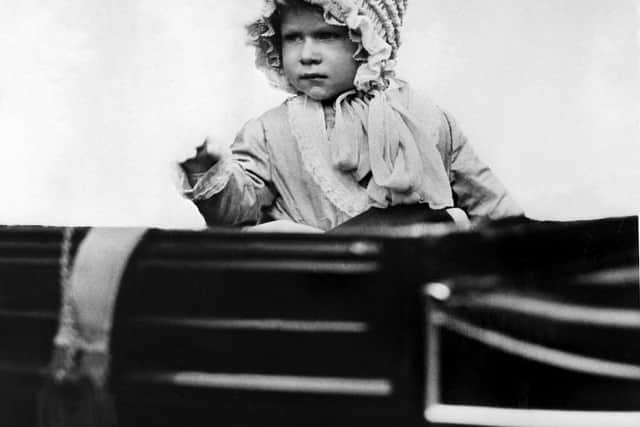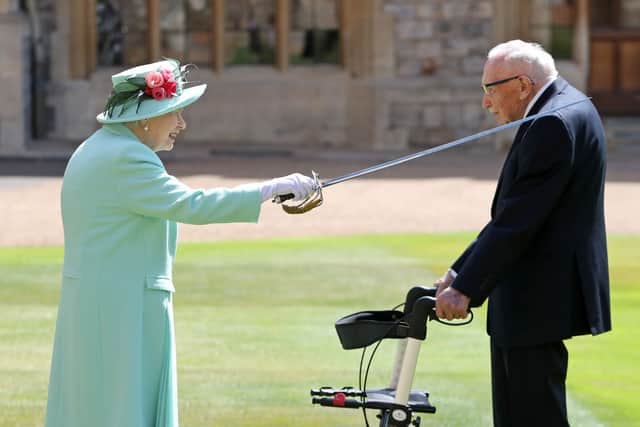Queen Elizabeth II 1926 - 2022 obituary: longest-serving monarch who was never meant to ascend the throne
and live on Freeview channel 276
Queen Elizabeth II, who today died aged 96, sat on the British throne for an incredible 70 years and is the longest-reigning monarch in the history of the United Kingdom.
In June, she celebrated her Platinum Jubilee - with admirers flocking in their thousands to both Buckingham Palace and various other events across the country to celebrate the beloved royal.
Advertisement
Hide AdAdvertisement
Hide AdShe was one of the most recognisable people in the world, and has for decades been a figure of stability and comfort for the nation through some tough economic and political times.


From the Second World War to the 9/11 terror attacks and the coronavirus pandemic, the Queen has been to many someone to look at for hope in times of crisis.
But she’s also been witness through her reign to some of the great developments of the last century - from watching the first man walk on the moon, to the UK’s hosting of the Olympics, to the birth of the internet.
People across the country will be united in a period of national mourning as tributes flood in for a queen who touched the hearts of so many.


Advertisement
Hide AdAdvertisement
Hide AdQueen Elizabeth II, whose full name was Elizabeth Alexandra Mary Windsor, was never supposed to be Queen.
Born on 21 April, 1926, during the reign of her grandfather, George V, she was at the time third in line - behind her uncle, Prince Edward, and her own father, Prince Albert.
She was assumed to be a relatively minor royal, as at this point Prince Edward was still young and expected to marry and produce an heir, and it was still possible that Prince Albert, her father, would produce a son - who would take precedence over Elizabeth.
The young princess grew up in London with her sister Margaret and enjoyed trips to Balmoral Castle in Scotland - which remained one of her favourite places for the rest of her life and is where she ultimately passed away.


Advertisement
Hide AdAdvertisement
Hide AdWith lessons focusing on history, language, literature and music, the sisters were educated at home under the supervision of their mother and governess, Marion Crawford.
‘Lilibet’, as she was called, was known for being fond of horses and dogs, and was also once called a “character” by her future first Prime Minister Winston Churchill who once visited the family in Scotland when she was just two years old.
He was reportedly taken with her charm.
In 1936, Elizabeth’s grandfather died and her uncle succeeded to the throne as Edward VIII. But a year later he abdicated in favour of his brother Albert - who became King George VI in tribute to his father.


Elizabeth was suddenly heir to the throne.
During the Second World War, she and Margaret were moved away from the Blitz and spent much of their time living at Balmoral Castle and Windsor Castle, separated from their parents.
Advertisement
Hide AdAdvertisement
Hide AdIn 1947, Princess Elizabeth went with the king and queen to South Africa. She has since become the world’s most travelled head of state, undertaking many historic overseas visits.
Upon her return to the UK, her betrothal to distant cousin Lieutenant Philip Mountbatten of the Royal Navy, formerly Prince Philip of Greece and Denmark, was announced.


They were married at Westminster Abbey on November 20, 1947, and Philip became the Duke of Edinburgh.
Their first child, Prince Charles, was born November 14, 1948, at Buckingham Palace, and they later had Anne, Andrew and Edward.
Advertisement
Hide AdAdvertisement
Hide AdPrince Philip died aged 99 on 9 April 2021, with the Queen describing him as her “strength and stay”.
In 1951, the health of King George VI started to seriously decline, and Princess Elizabeth represented him at the Trooping the Colour and on various other state occasions.
On February 6, 1952, after 16 years on the throne, King George VI died aged just 56. Elizabeth became Queen much sooner than anyone had expected, aged 25.
She carried out her first state opening of Parliament on November 4, 1952 and her coronation was held at Westminster Abbey on June 2, 1953.


Advertisement
Hide AdAdvertisement
Hide AdIn November 1953, the Queen and the Duke of Edinburgh made a six-month round-the-world tour of the Commonwealth, which included the first visit to Australia and New Zealand by a reigning British monarch.
Throughout her reign, Queen Elizabeth II became known for her sense of duty and her devotion to a life of service.
She has been present at many landmark events, making the country’s first ever direct dial call - from Bristol to Edinburgh - in 1958, and sending her first email in 1976.
Excluding 1969, she has made a Christmas Day broadcast for every year of her reign.


Advertisement
Hide AdAdvertisement
Hide AdQueen Elizabeth II has continued old traditions, such as conducting the State Opening of Parliament (which she has done a total of 65 times) - and even started new ones.
During a royal tour of Australia and New Zealand in 1970 for instance, she bucked centuries of royal tradition by taking a casual stroll to greet crowds rather than waving to them from a protected distance.
This is now regular practice for royals, and has become known as the royal ‘Walkabout.’
In 1977, Queen Elizabeth II celebrated her Silver Jubilee - and two years later, saw the UK’s first female Prime Minister, Margaret Thatcher, take office.


Advertisement
Hide AdAdvertisement
Hide AdHer regular duties included weekly meetings with the Prime Minister, and the Trooping of the Colour.
At the 1981 Trooping of the Colour, she was shot at - and widely praised for controlling her horse and continuing with the ceremony.
1992 was the Queen’s “annus horribilis” as she called it, when Prince Charles and Lady Diana separated, Princess Anne divorced her husband, Prince Andrew separated from his wife, and Windsor Castle caught fire.


Diana, the “people’s princess”, died in 1997, and Elizabeth’s mother died in 2002 - tainting the celebrations for the Queen’s Golden Jubilee which took place in the same year.
Advertisement
Hide AdAdvertisement
Hide AdIn her time as Queen, she has had 15 prime ministers, met with 12 US presidents, five Popes, and the leaders of all other major faiths of the UK.
On 21 December 2007, the Queen became the longest-lived British monarch, surpassing her great-great grandmother Queen Victoria.


In 2012, Queen Elizabeth II celebrated her Diamond Jubilee, and also opened the 2012 London Olympic Games with ‘James Bond’. She was called the “most memorable Bond Girl yet” by Sir Kenneth Brannagh.
In recent years, she watched as the historic Brexit Referendum was held, coronavirus plunged the world into chaos, and Russia launched its invasion of Ukraine.
Advertisement
Hide AdAdvertisement
Hide AdDuring the pandemic, she moved to ‘HMS Bubble’ at Windsor Castle, but still conducted her duties - meeting with then-Prime Minister Boris Johnson over the phone - and addressing the nation in a broadcast seen by nearly 25 million people.


When restrictions eased, she returned to in-person duties - such as knighting Captain Tom Moore.
Her most recent royal meeting was to invite Liz Truss to form a Government, a meeting which she carried out at Balmoral Castle in Aberdeenshire due to her declining health.


Tributes to the Queen have begun from leaders across the world, and will continue for many days to come.
Advertisement
Hide AdAdvertisement
Hide AdFor a queen who was never supposed to be, Queen Elizabeth II defied expectations and became one of the most historic, record-breaking monarchs of all time.
She captured the hearts of many, oversaw periods of intense social change, and remained a figurehead for the nation throughout.
Queen Elizabeth II is survived by her four children, Prince Charles, Princess Anne, Prince Andrew and Prince Edward, eight grandchildren, including Prince William and Prince Harry, and 12 great-grandchildren.
Comment Guidelines
National World encourages reader discussion on our stories. User feedback, insights and back-and-forth exchanges add a rich layer of context to reporting. Please review our Community Guidelines before commenting.
